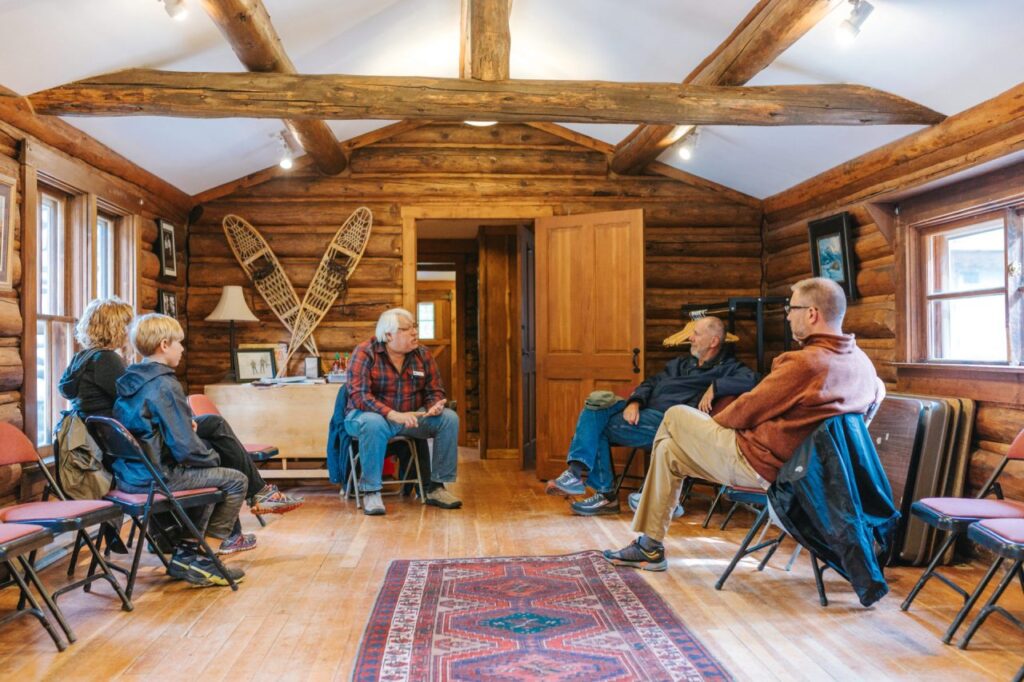Highlights of the Murie Legacy
The Murie Ranch landmark district is in Grand Teton National Park. The district is chiefly significant for its association with the conservationists Olaus Murie, his wife Margaret (Mardy) Murie and scientist Adolph Murie and his wife Louise.
The Murie Ranch – described by Olaus Murie as the heart of American wilderness – became the backdrop for discussion and debate among the Murie family and other environmental leaders. Their efforts shaped the conservation movement, culminating with the passage of the Wilderness Act and the protection of numerous nationally designated wild areas.
Olaus J. Murie
Olaus Murie, born in 1889 in Moorhead, Minnesota, became an important force in early wildlife ecology and conservation. After studying zoology at Pacific University in Oregon, Olaus began work as a conservation officer for the Oregon State Game and Fish Department. This led him to an opportunity to travel with the Carnegie Museum, collecting wildlife specimens in Hudson Bay. He went on to work for the United States Biological Survey (USBS) conducting pioneering wildlife studies in Alaska, Wyoming and around the country for over thirty years. In 1927, following his marriage to Mardy Murie, Olaus came to Jackson Hole to direct field studies of the threatened elk herds. Murie’s books, such as The Elk of North America and Alaska-Yukon Caribou, are standard texts even today. His systems-based approach to game management was controversial in the USBS, but Olaus persevered in his efforts for conservation of wildlife habitat. In 1945, Olaus was named Director of the Wilderness Society and The Murie Ranch became the Wilderness Society’s headquarters. His efforts eventually helped to bring about the creation of the Arctic National Wildlife Refuge and passage of the Wilderness Act. In 1959, Olaus was awarded the prestigious Audubon Medal for his dedication to scientific excellence and conservation. Upon his death in 1963, he was praised as “the one person who best personified wilderness in our culture”.
Aldoph Murie
Adolph Murie was born in 1899 in Moorhead, Minnesota, ten years after his half-brother Olaus. In 1922, he joined Olaus in the Brooks Range of Alaska to study caribou; the experience inspired his life’s work. He spent the better part of thirty-two years working for the National Park Service, undertaking pioneering studies that were published in three books: The Wolves of Mount McKinley, The Ecology of the Coyote in the Yellowstone, and The Grizzlies of Mount McKinley. He received the Distinguished Service Award from the National Park Service and the prestigious John Burroughs Medal. Like his brother, Adolph’s approach to wildlife management ran contrary to current opinion and took into account whole ecosystems, rather than focusing on single organisms. In 1945, his family settled in Jackson Hole where he continued his naturalist activities until his death in 1974. He believed that “life is richest where the greatest diversity exists in the natural order.”
Mardy Murie
Margaret (Mardy) Elizabeth Thomas was born in Seattle in 1902, but spent her childhood in Fairbanks, Alaska. In 1924, she was the first woman to graduate from the University of Alaska. She married Olaus Murie in 1924, beginning a lifetime of travel, scientific research and involvement in conservation activities. Mardy and Olaus had three children: Martin, Joanne and Don. Mardy is the author of several books including: Two in the Far North and Wapiti Wilderness. She played a key role in the passage of the Alaska National Interest Lands Conservation Act, the greatest land preservation act in U.S. history. Mardy served on the council of the Wilderness Society, was on the founding board of Teton Science Schools, and is an Honorary Park Ranger. She received an Honorary Doctorate from the University of Alaska and the prestigious Audubon Medal. In 1998, she was awarded the Presidential Medal of Freedom by President Bill Clinton for her lifetime service to conservation. Mardy lived on the Murie Ranch in Grand Teton National Park until her death in 2003.
Louise Murie Macleod
Louise Gillette was born in 1912 in Fairbanks, Alaska and lived there for the first twelve years of her life. In 1924, her family moved to Washington state. She attended Reed College and the University of Michigan. In 1932, she married Adolph Murie, the half-brother of Olaus. They had two children, Jan and Gail. Louise traveled with Adolph as he pursued his naturalist work, spending twenty-five summers and a few winters in Mount McKinley National Park. Several years after Adolph’s death, Louise married a close family friend, Dr. Don MacLeod, a well -known Jackson physician. Louise lived with him until his death in 1983. Louise continued her conservation and community work: she was active with Teton Science Schools and served on the boards of the Jackson Hole Conservation Alliance and The Murie Center. Louise died in 2012.
Tour
The Murie Ranch
The Murie Ranch was designated a National Historic Landmark on February 21, 2006. This designation formally recognizes the contributions of the Murie families to wildlife management and biological science as well as to the twentieth century conservation movement.
The Murie Ranch became a campus of Teton Science Schools in 2015. Today, the Murie Ranch is a place where Teton Science Schools’ mission is exemplified on a daily basis. Visitors arrive at the ranch, curious about its origin and purpose, and are greeted by Ranch Docents. The Docent’s daily tours take visitors on an engaging journey through the Murie history as he brings the homestead to life with anecdotes and stories. Throughout the summer, Front Porch Conversations at Mardy’s cabin provide an opportunity to discuss themes of conservation and place-based education.
Ted and Joan Major, founders of Teton Science Schools, were friends of Olaus and Mardy Murie and supporters of their work. The Muries and Majors started their work separately, but their legacies have merged and grown into an organization that upholds the qualities they held dear–curiosity, engagement and leadership


